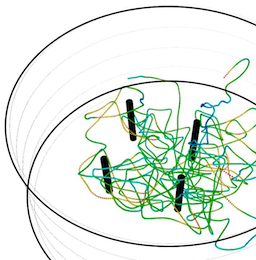I have been collaborating with the Dickinson lab, in particular with Andrew Straw (who now has his own lab at the Institute of Molecular Pathology in Vienna, Austria) on the quantitative characterization of visually-driven behavior in Drosophila Melanogaster.
The video shows the kind of simulated
data I am working with. Using a special apparatus with 11 cameras, the animal is tracked with a precision of a few millimiters. An ad-hoc simulator allows to reconstruct the visual stimulus experienced by the animal at a reasonable level of accuracy.
We then analyze the data asking whether we can infer the neural processing happening in the animal brain.
Video: Simulated visual input from tracking data of free-flying Drosophila Melanogaster (watch on Vimeo). On the right, you can see the simulated visual stimulus. On the left, the position of the fly in the arena (1m radius). Note that the video is slowed down about 10x with respect to the real data: fruit flies are very fast! (real time is in the left corner) Watch the video full-screen to appreciate the details.
Recent papers

Andrea Censi*, Andrew D. Straw*, Rosalyn W. Sayaman, Richard M. Murray, and Michael H. Dickinson.
Discriminating external and internal causes for saccade initiation in freely flying Drosophila.
PLOS Computational Biology, February 2013.
 pdfdoi
pdfdoi supp. material
supp. material slides
slides
bibtex
@article{censi13saccade,
author = "Censi*, Andrea and Straw*, Andrew D. and Sayaman, Rosalyn W. and Murray, Richard M. and Dickinson, Michael H.",
volume = "9",
doi = "10.1371/journal.pcbi.1002891",
title = "Discriminating external and internal causes for saccade initiation in freely flying {\em Drosophila}",
url = "http://purl.org/censi/2011/saccade",
abstract = "As animals move through the world in search of resources, they change course in reaction to both external sensory cues and internally- generated programs. Elucidating the functional logic of complex search algorithms is challenging because the observable actions of the animal cannot be unambiguously assigned to externally- or internally-triggered events. We present a technique that addresses this challenge by assessing quantitatively the contribution of external stimuli and internal processes. We apply this technique to the analysis of rapid turns (saccades) of freely flying Drosophila melanogaster. We show that a single scalar feature computed from the visual stimulus experienced by the animal is sufficient to explain a majority (93%) of the turning decisions. We automatically estimate this scalar value from the observable trajectory, without any assumption regarding the sensory processing. A posteriori, we show that the estimated feature field is consistent with previous results measured in other experimental conditions. The remaining turning decisions, not explained by this feature of the visual input, may be attributed to a combination of deterministic processes based on unobservable internal states and purely stochastic behavior. We cannot distinguish these contributions using external observations alone, but we are able to provide a quantitative bound of their relative importance with respect to stimulus-triggered decisions. Our results suggest that comparatively few saccades in free-flying conditions are a result of an intrinsic spontaneous process, contrary to previous suggestions. We discuss how this technique could be generalized for use in other systems and employed as a tool for classifying effects into sensory, decision, and motor categories when used to analyze data from genetic behavioral screens.",
number = "2",
month = "February",
slides = "http://purl.org/censi/research/2012-sicb-saccades.pdf",
year = "2013",
pdf = "http://www.ploscompbiol.org/article/fetchObject.action?uri=info%3Adoi%2F10.1371%2Fjournal.pcbi.1002891&representation=PDF",
journal = "PLOS Computational Biology"
}
What goes on in a fruit fly's head while it flies?
In this paper we try to identify the dependence of the decision processes
on the external stimulus experienced by the fly. Remarkably, we are able to
say a great deal about internal sensory processing by just observing the
external behavior.
read more...
 pdfdoi
pdfdoi supp. material
supp. material
 slides
slides